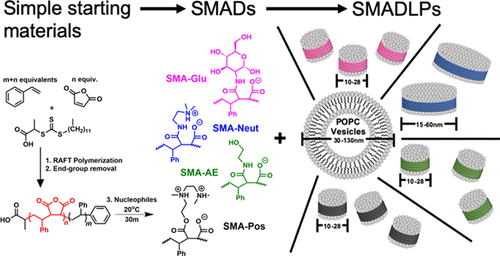当前位置:
X-MOL 学术
›
Biomacromolecules
›
论文详情
Our official English website, www.x-mol.net, welcomes your
feedback! (Note: you will need to create a separate account there.)
Simple Derivatization of RAFT-Synthesized Styrene-Maleic Anhydride Copolymers for Lipid Disk Formulations.
Biomacromolecules ( IF 5.5 ) Pub Date : 2020-02-27 , DOI: 10.1021/acs.biomac.0c00041 Kevin M Burridge 1 , Benjamin D Harding 1 , Indra D Sahu 1, 2 , Madison M Kearns 1 , Rebecca B Stowe 1 , Madison T Dolan 1 , Richard E Edelmann 3 , Carole Dabney-Smith 1 , Richard C Page 1 , Dominik Konkolewicz 1 , Gary A Lorigan 1
Biomacromolecules ( IF 5.5 ) Pub Date : 2020-02-27 , DOI: 10.1021/acs.biomac.0c00041 Kevin M Burridge 1 , Benjamin D Harding 1 , Indra D Sahu 1, 2 , Madison M Kearns 1 , Rebecca B Stowe 1 , Madison T Dolan 1 , Richard E Edelmann 3 , Carole Dabney-Smith 1 , Richard C Page 1 , Dominik Konkolewicz 1 , Gary A Lorigan 1
Affiliation

|
Styrene-maleic acid copolymers have received significant attention because of their ability to interact with lipid bilayers and form styrene-maleic acid copolymer lipid nanoparticles (SMALPs). However, these SMALPs are limited in their chemical diversity, with only phenyl and carboxylic acid functional groups, resulting in limitations because of sensitivity to low pH and high concentrations of divalent metals. To address this limitation, various nucleophiles were reacted with the anhydride unit of well-defined styrene-maleic anhydride copolymers in order to assess the potential for a new lipid disk nanoparticle-forming species. These styrene-maleic anhydride copolymer derivatives (SMADs) can form styrene-maleic acid derivative lipid nanoparticles (SMADLPs) when they interact with lipid molecules. Polymers were synthesized, purified, characterized by Fourier-transform infrared spectroscopy, gel permeation chromatography, and nuclear magnetic resonance and then used to make disk-like SMADLPs, whose sizes were measured by dynamic light scattering (DLS). The SMADs form lipid nanoparticles, observable by DLS and transmission electron microscopy, and were used to reconstitute a spin-labeled transmembrane protein, KCNE1. The polymer method reported here is facile and scalable and results in functional and robust polymers capable of forming lipid nanodisks that are stable against a wide pH range and 100 mM magnesium.
中文翻译:

RAFT合成的苯乙烯-马来酸酐共聚物的简单衍生化,用于脂质盘配方。
苯乙烯-马来酸共聚物由于其与脂质双层相互作用并形成苯乙烯-马来酸共聚物脂质纳米颗粒(SMALP)的能力而备受关注。但是,这些SMALP的化学多样性受到限制,仅具有苯基和羧酸官能团,由于对低pH值和高浓度的二价金属敏感,因此存在局限性。为了解决该限制,使各种亲核试剂与明确定义的苯乙烯-马来酸酐共聚物的酸酐单元反应,以评估形成新的形成脂质盘纳米颗粒的物质的潜力。这些苯乙烯-马来酸酐共聚物衍生物(SMAD)与脂质分子相互作用时,可以形成苯乙烯-马来酸衍生物脂质纳米颗粒(SMADLP)。合成,纯化聚合物,用傅立叶变换红外光谱,凝胶渗透色谱和核磁共振进行表征,然后用于制备盘状SMADLP,其大小通过动态光散射(DLS)测量。SMAD形成脂质纳米颗粒,可通过DLS和透射电镜观察到,并用于重构自旋标记的跨膜蛋白KCNE1。本文报道的聚合物方法简便易行,可扩展,可生成功能强大的聚合物,能够形成对宽pH范围和100 mM镁稳定的脂质纳米盘。可通过DLS和透射电子显微镜观察,并用于重构自旋标记的跨膜蛋白KCNE1。本文报道的聚合物方法简便易行,可扩展,可生成功能强大的聚合物,能够形成对宽pH范围和100 mM镁稳定的脂质纳米盘。可通过DLS和透射电子显微镜观察,并用于重构自旋标记的跨膜蛋白KCNE1。本文报道的聚合物方法简便易行,可扩展,可生成功能强大的聚合物,能够形成对宽pH范围和100 mM镁稳定的脂质纳米盘。
更新日期:2020-02-27
中文翻译:

RAFT合成的苯乙烯-马来酸酐共聚物的简单衍生化,用于脂质盘配方。
苯乙烯-马来酸共聚物由于其与脂质双层相互作用并形成苯乙烯-马来酸共聚物脂质纳米颗粒(SMALP)的能力而备受关注。但是,这些SMALP的化学多样性受到限制,仅具有苯基和羧酸官能团,由于对低pH值和高浓度的二价金属敏感,因此存在局限性。为了解决该限制,使各种亲核试剂与明确定义的苯乙烯-马来酸酐共聚物的酸酐单元反应,以评估形成新的形成脂质盘纳米颗粒的物质的潜力。这些苯乙烯-马来酸酐共聚物衍生物(SMAD)与脂质分子相互作用时,可以形成苯乙烯-马来酸衍生物脂质纳米颗粒(SMADLP)。合成,纯化聚合物,用傅立叶变换红外光谱,凝胶渗透色谱和核磁共振进行表征,然后用于制备盘状SMADLP,其大小通过动态光散射(DLS)测量。SMAD形成脂质纳米颗粒,可通过DLS和透射电镜观察到,并用于重构自旋标记的跨膜蛋白KCNE1。本文报道的聚合物方法简便易行,可扩展,可生成功能强大的聚合物,能够形成对宽pH范围和100 mM镁稳定的脂质纳米盘。可通过DLS和透射电子显微镜观察,并用于重构自旋标记的跨膜蛋白KCNE1。本文报道的聚合物方法简便易行,可扩展,可生成功能强大的聚合物,能够形成对宽pH范围和100 mM镁稳定的脂质纳米盘。可通过DLS和透射电子显微镜观察,并用于重构自旋标记的跨膜蛋白KCNE1。本文报道的聚合物方法简便易行,可扩展,可生成功能强大的聚合物,能够形成对宽pH范围和100 mM镁稳定的脂质纳米盘。











































 京公网安备 11010802027423号
京公网安备 11010802027423号